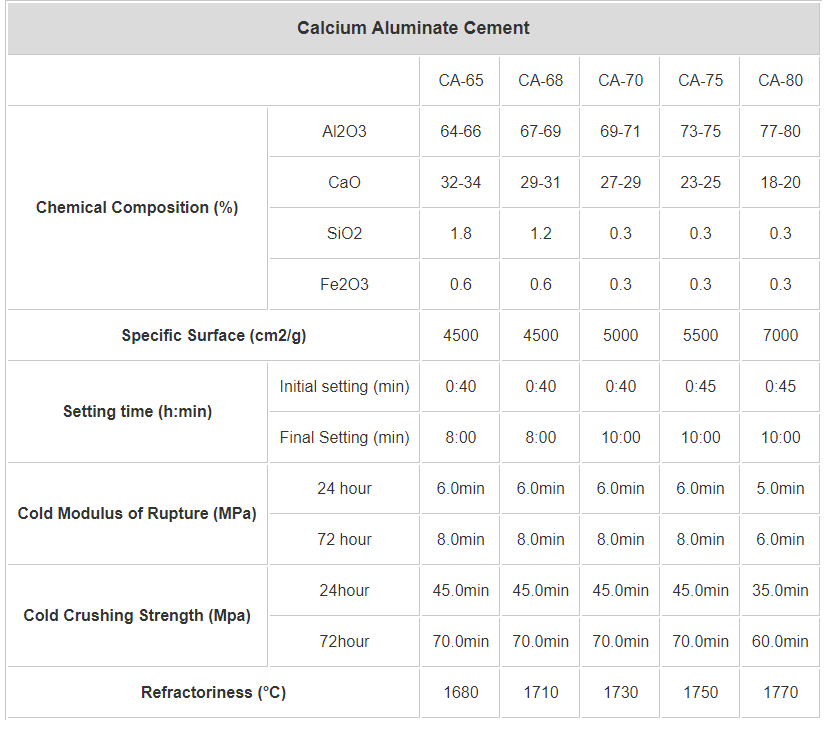Calcium aluminum cement:
Also known as high aluminum cement, is an important special cement. It is widely used in construction, metallurgy, chemical industry and other fields with its excellent properties such as high strength, rapid hardening, high temperature resistance and corrosion resistance. This article will give a detailed introduction to the composition, characteristics, production process, application and precautions of calcium aluminum cement.
Composition:
The main component of calcium aluminum cement is calcium aluminate (CaAl₂O₄), and the remaining components included calcium aluminate (Ca₂Al₂O₅) and tricalcium aluminate (Ca₃Al₂O₆). The raw materials are mainly
bauxite (the main source of alumina) and limestone (the main source of calcium carbonate). During the production process, the raw materials are calcined at high temperature to produce calcium aluminate minerals, which
have excellent hydraulic hardness and early strength.
Characteristics:
- High strength: hardens quickly and has high early strength. It can usually reach the strength of ordinary Portland cement in 28 days within 24 hours. Therefore, it is particularly suitable for
- engineering projects that require rapid construction and early use.
- High temperature resistance: Calcium aluminum cement has good high temperature resistance and can still maintain its strength and stability under high temperature environment. It is suitable for various furnace lining
- materials in high temperature industry.
- Corrosion resistance: Calcium aluminum cement has good corrosion resistance to chemical substances such as acids, alkalis, sulfates, etc., so it is widely used in corrosive environments such as chemical plants, sewage
- treatment plants and seaports.
- Frost resistance: Calcium aluminum cement can also maintain good performance under low temperature conditions, is not easily affected by freeze-thaw cycles, and is suitable for construction projects in cold areas.
Production process:
- The production process of calcium aluminum cement includes steps such as raw material pretreatment, high temperature calcination, grinding and packaging.
- Raw material pretreatment: First, bauxite and limestone are mixed in proportion, and crushed and ground to achieve a suitable fineness.
- High temperature calcination: The mixed raw materials are calcined at high temperature in a rotary kiln or a vertical kiln. The calcination temperature is generally between 1350-1450℃. At high temperature, the aluminum
- oxide and calcium oxide in the raw materials react chemically to form calcium aluminate minerals.
- Grinding: After the calcined clinker is cooled, it is ground again to make the finished calcium-aluminum cement. During the grinding process, an appropriate amount of gypsum can be added to adjust the setting time of the
- cement.
- Packaging: The ground calcium-aluminum cement is packaged, stored and transported.
Application:
- Due to its excellent performance,it is widely used in many fields:
- Construction engineering: it is often used in projects that require rapid setting and high early strength, such as bridges, roads, airport runways and other emergency repair projects. In addition, it is
- also used in construction projects in cold areas because of its excellent antifreeze properties.
- Refractory materials: Calcium-aluminum cement is an important raw material for the production of refractory materials such as refractory castables and refractory bricks. These materials are widely used in high-temperature
- industries such as metallurgy, glass, and cement.
- Chemical industry: Due to the corrosion resistance of calcium-aluminum cement, it is used in construction projects in corrosive environments such as chemical plants and sewage treatment plants.
- Port engineering: it has strong resistance to seawater corrosion and is suitable for projects such as seaport terminals and offshore buildings that require resistance to seawater corrosion.
Precautions for using:
- Mixing ratio: When using, the water-cement ratio and sand-gravel ratio should be strictly controlled to ensure the quality of concrete or mortar.
- Mixing time: it hardens quickly, and the mixing time should be controlled to prevent segregation.
- Maintenance conditions: During the hardening process, it is necessary to maintain appropriate humidity and temperature to avoid early drying and high temperature exposure.
- Combination with other cements: Should not be mixed with ordinary silicate cement to avoid problems such as expansion cracks and strength reduction.
- Construction environment: During construction, attention should be paid to ambient temperature and humidity, and construction should be avoided under conditions of too high or too low temperature to ensure the best
- performance.
Conclusion:
Calcium aluminum cement plays an important role in construction, metallurgy, chemical industry and other fields with its excellent characteristics such as high strength, fast hardening, high temperature resistance and
corrosion resistance. Reasonable use of it can significantly improve the quality and service life of the project, reduce the frequency of maintenance and replacement, and thus save costs. In specific
applications, the appropriate type of calcium-aluminum cement should be selected according to project requirements and use environment, and the construction process should be strictly controlled to ensure the smooth
progress and long-term stability of the project.


